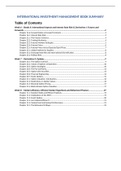Samenvatting
Summary International Investment Management Endterm
- Instelling
- Universiteit Utrecht (UU)
- Boek
- ISE Investments
A summary containing the chapters of the book that need to be studied for the endterm of International Investment Management.
[Meer zien]





